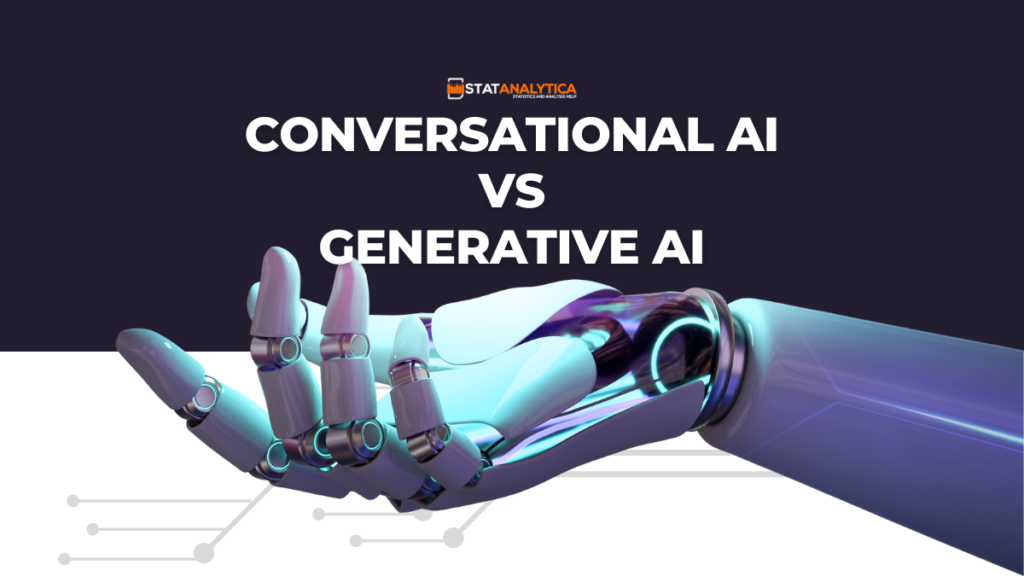In today’s world, technology is advancing at a rapid pace, often bringing new terms and concepts that can sometimes be confusing. Two such terms that you might have come across are “Conversational AI” and “Generative AI”. These technologies are reshaping how we interact with computers and the internet, making them more human-like in their responses and capabilities. In this blog, we will explore what each of these terms means, how they are different (conversational AI vs generative AI), and where they are used.
What is Conversational AI?
Table of Contents
Conversational AI means computers can talk with people using everyday language. Think of chatting with a website’s chatbot or using Siri or Alexa. These systems understand what you say and give the right answers.
Characteristics of Conversational AI
- Natural Language Processing (NLP): This technology allows AI to understand and interpret human language. It involves tasks like text parsing, sentiment analysis, and language translation.
- Speech Recognition: Conversational AI can also understand spoken language through speech recognition technology. This enables virtual assistants to respond to voice commands.
- Context Awareness: Effective conversational AI systems can recall past conversations and utilize that information to offer more appropriate and helpful replies. For example, if you ask a virtual assistant about the weather, it might remember your location from a previous query.
- Applications: Conversational AI chatbot is widely used in customer service chatbots, virtual assistants, and even in smart home devices to control appliances through voice commands.
Example of Conversational AI
Imagine you ask a virtual assistant like Google Assistant, “What’s the weather like today?” The AI understands your question, checks the weather forecast for your location, and replies with the current weather conditions.
What is Generative AI?
Generative AI, on the other hand, is a broader category of artificial intelligence that involves machines creating new content such as images, text, or even music. Unlike conversational AI, which focuses on interacting with humans through conversation, generative AI is about generating new content that is often creative and original.
Characteristics of Generative AI
- Creativity: Generative AI algorithms are capable of creating new content that mimics human creativity. For example, generating realistic images of people who do not exist or composing music.
- Training on Data: These systems are typically trained on large datasets to learn patterns and generate content that resembles the input data. For instance, a generative AI trained on Shakespeare’s works might produce new text in a similar style.
- Applications: Generative AI finds applications in creative fields such as art, music, and design, as well as in fields like medicine and science for generating hypotheses or data.
Example of Generative AI
An example of generative AI is DeepDream, a program developed by Google that uses neural networks to generate images that emphasize patterns and textures in existing images. These generated images often have surreal and dream-like qualities.
Key Differences: Conversational AI vs Generative AI
To understand the contrast between conversational AI and generative AI better, let’s summarize their differences in a table:
| Feature | Conversational AI | Generative AI |
| Primary Function | Engaging in human-like conversation | Generating new content (text, images, etc.) |
| Focus | Understanding and responding to language | Creating original content based on learned patterns |
| Examples | Chatbots, Virtual Assistants (Siri, Alexa) | DeepDream, Text Generation Models (GPT-3) |
| Applications | Customer service, Virtual Assistants, IoT devices | Art generation, Content creation, Scientific research |
| Technologies Used | Natural Language Processing, Speech Recognition | Neural Networks, Deep Learning Techniques |
What Are The Real-World Applications?
- Conversational AI: Companies use chatbots to handle customer queries on websites, reducing the need for human customer service agents.
- Generative AI: Artists use generative adversarial networks
(GANs) to create unique artworks that blend styles from different periods.
How Is A Business Currently Leveraging Both AI Technologies?
Businesses are leveraging Conversational AI and Generative AI in various ways to enhance efficiency, improve customer interactions, and drive innovation:
Conversational AI
- Customer Support: Chatbots handle customer queries, providing 24/7 support and reducing response times.
- Virtual Assistants: Assistants like Siri and Alexa assist users with tasks, schedules, and information retrieval.
- Sales and Marketing: AI-powered chatbots can qualify leads, recommend products, and personalize marketing interactions.
Generative AI
- Content Creation: AI generates marketing content, product descriptions, and even social media posts.
- Design and Creativity: Used in art, music, and fashion industries to create new designs and compositions.
- Research and Development: AI aids in generating hypotheses, analyzing data patterns, and automating experimentation in scientific research.
These technologies streamline operations, enhance user experiences, and foster innovation across sectors.
What Would Be The Future Outlook For AI?
The future outlook for AI is promising and is expected to shape various aspects of society and business in profound ways:
- Advancements in Automation: AI will continue to automate routine tasks across industries, increasing efficiency and reducing costs.
- Enhanced Personalization: AI algorithms will become more sophisticated, enabling highly personalized experiences in customer service, marketing, and content creation.
- Expansion in Healthcare: AI applications in healthcare will improve diagnostics, drug discovery, and personalized medicine, leading to better patient outcomes.
- Ethical and Regulatory Challenges: As more people use AI, we’ll pay more attention to making sure it’s fair, respects privacy, and follows rules to develop and use it responsibly.
- Integration with IoT and Edge Computing: AI will be really important in handling and studying huge amounts of data from IoT devices. This helps make quick decisions and predict when maintenance is needed.
- AI in Education: AI-powered tutoring systems and personalized learning platforms will transform education, adapting to individual student needs and learning styles.
- Collaborative AI: Humans and AI systems will collaborate more seamlessly, augmenting human capabilities in problem-solving, creativity, and decision-making.
Conclusion
In conclusion, while conversational AI focuses on enabling machines to understand and respond to human language, generative AI expands the horizon by creating new and original content. Both technologies are transforming various industries and everyday interactions, making our interactions with technology more seamless and intelligent.
Understanding these distinctions (conversational AI vs generative AI) can help us appreciate how AI is evolving and shaping the future of human-computer interactions.
Whether you’re chatting with a virtual assistant or marveling at a computer-generated masterpiece, you’re witnessing the power and potential of artificial intelligence in action.
As technology continues to advance, it’s exciting to imagine what new capabilities these AI systems will bring next, and how they will continue to impact our lives in meaningful ways.


